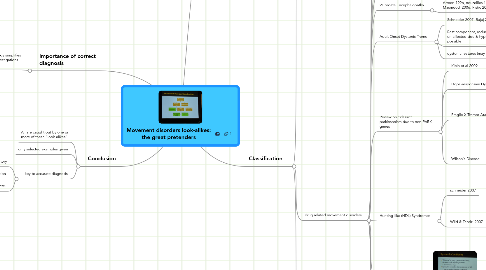
1. Movement Disorder Classification
1.1. picture
2. Importance of correct diagnosis
2.1. Identifying the phenomenology simplifies the diagnostic process (ie investigations etc)
3. Classification
3.1. Paediatric disorders
3.1.1. infantile masturbation
3.1.1.1. may be misdiagnosed as seizures or dystonia
3.1.1.2. typically in girls <3yrs
3.1.2. Sandifer syndrome
3.1.2.1. neonatal period or up to 3 yrs
3.1.2.2. intermittend postures or hyperextension of head, often with rotating or tilting
3.1.2.3. associated with gastro-oesophageal reflux
3.1.2.4. Kabakus & kurt 2006
3.1.3. Benign torticullis of infancy
3.1.3.1. You don't want to miss
3.1.3.1.1. posterior fossa tumours
3.2. drug related movement disorders
3.2.1. Drug effects may mimic any movement disorder
3.2.2. Effects may be:
3.2.2.1. acute
3.2.2.2. tardive
3.2.2.2.1. chronic, ongoing medication use
3.2.2.2.2. withdrawal or covert
3.2.3. Onset may occur after relatively short exposure!
3.2.4. Drug induced parkinsonism
3.2.4.1. Normal FP-CIT SPECT Scan
3.2.5. Valproate Encephalopathy
3.2.5.1. Armon 1996, nouzeilles 1999, Masmoudi 2006, Ristic 2006
3.2.6. Adult Onset Dystonic Tremor
3.2.6.1. Schneider 2007, Bajaj 2010
3.2.6.2. Rest component, reduced arm swing on affected side & hypomimia all possible
3.2.6.3. dystonic features (may be subtle)
3.2.7. Review on "classic" parkinsonism due to non-PARK genes
3.2.7.1. Klein et al 2009
3.2.7.2. Dopa-responsive Dystonia
3.2.7.2.1. TH mutations
3.2.7.2.2. GCH1 mutation
3.2.7.3. Fragile X Tremor-Ataxia Syndrome
3.2.7.3.1. Moderate expansion of CGG trinucleotide in FMRI
3.2.7.4. Wilson's Disease
3.2.7.4.1. picture
3.2.8. Hunting-like (HDL) Syndromes
3.2.8.1. schneider 2007
3.2.8.2. Wild & Tabrizi 2007
3.2.8.2.1. Other causes of HD Phenocopies
3.2.9. Systemic Conditions
3.2.9.1. picture
3.2.10. Neuronal immune disorders of CNS
3.2.10.1. Associated with paraneoplastic disorders but may also be found in "idiopathic" disorders
3.2.10.2. Anitgenic target may be:
3.2.10.2.1. intracellular (non pathogenic?)
3.2.10.2.2. neuronal surface ...
3.2.10.2.3. Graus et al 2010
3.2.10.3. NMDA Encephalitis
3.2.10.3.1. Dalmau 2009
3.2.10.4. Glucose Transporter-1 Deficiency
3.2.10.4.1. Leen 2010
3.2.10.4.2. Impaired glucose transport into the brain
3.2.10.4.3. CSF with less glucose than normal
3.2.10.4.4. Ketogenic diet could help the patients.
3.2.11. Psychogenic movement disorders
3.2.11.1. hinson & haren 2006
3.3. Atypical presentations of classic movement disorders
4. Conclusion
4.1. All are caught out by one or more of these "look-alikes"
4.2. only selected examples given
4.3. key to accurate diagnosis
4.3.1. methodological history
4.3.2. careful examination
4.3.3. etc.
